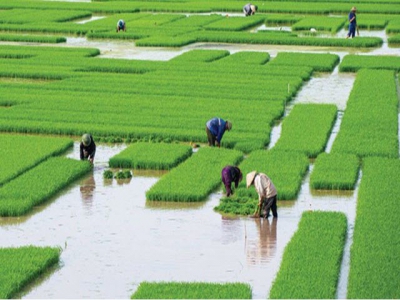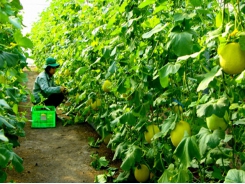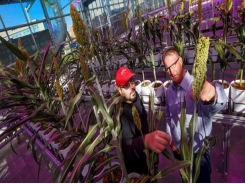Agriculture restructuring a work in progress

Restructuring in agriculture, forestry and fisheries has had a positive impact but efforts must be ongoing.
GDP growth in the third quarter of this year was the highest quarterly result year-on-year for the last eight years, with the agriculture, forestry and fisheries sector continuing to be a driving force, according to the General Statistics Office (GSO)’s General Director Nguyen Bich Lam. The level of growth being recorded in the sector, he said, paints an optimistic economic outlook that will create momentum for it being maintained over the remaining months of the year.
Notable growth
Vietnam’s agriculture exports are now the second-highest in Southeast Asia and 15th in the world. The competitiveness and position of the country’s agricultural products have improved significantly, as witnessed by surging export turnover to nearly 200 countries and territories.
According to the Ministry of Agriculture and Rural Development (MARD), despite facing natural disasters and economic downturns, the agriculture, forestry and fisheries sector recorded its highest growth ever in the 2012-2018 period, increasing by an average of 3.65 per cent and contributing an average of 8.8 per cent to overall growth.
The sector made up 13.93 per cent of GDP in the first nine months of 2018, behind industry and construction with 33.49 per cent and the service sector with 42.54 per cent. Total export turnover in the period was estimated at $29.54 billion, an increase of 9.3 per cent year-on-year, equal to 73 per cent of the annual plan, and exceeding the nine-month target by 1.3 per cent.
As at September there were 49,600 enterprises around Vietnam engaged in the manufacturing, processing and trading of agricultural products, accounting for 8 per cent of all enterprises in the country. Of these, 8,635 are directly involved in farming and 13,006 are agricultural cooperatives and over 62,550 cooperative groups, which were reorganized and newly established under the Law on Cooperatives approved in 2012.
Impressive growth in the first half of this year was a highlight, at 4.2 per cent in production value and 3.95-4.05 per cent in GDP; the highest in the last ten years. Mr. Nguyen Van Viet, Director of MARD’s Planning Department, said the results provide optimism and create a foundation for reaching the annual target.
According to a MARD overview of the last five years, agriculture growth averaged 2.55 per cent each year. Agricultural exports reached $157.49 billion, averaging $31.5 billion a year, up 51.2 per cent compared to the average in the previous five-year period. Labor productivity stood at VND35.5 million ($1,500) per worker, up VND10 million ($429) compared to 2012 and rising by an average of 6.67 per cent each year and double the target set in the 2013-2018 restructuring plan. Agricultural export revenue is expected to reach $40 billion this year, of which ten commodities are to earn export turnover of $1 billion or more and five, including shrimp, fruit, cashew nuts, coffee and wooden products, are to earn over $3 billion. The sector’s achievements are the fruit of its restructuring and transformation efforts, according to Mr. Lam, with stable prices and growing export markets being the main drivers.
Behind the growth
MARD’s review on the implementation of the five-year plan to restructure the agriculture sector towards improving added value and sustainable development showed that the process resulted in remarkable changes in mindsets and implementation, from the central to local levels. The institutional and policy framework for agriculture and rural development continues to be improved and is increasingly suitable and effective. Seven laws on agriculture were approved by the National Assembly in the period, while MARD simplified 241 administrative procedures.
“Agricultural growth in the first nine months of 2018 is evidence of effective restructuring,” said Dr. Dang Kim Son, former Director of the Institute of Policy and Strategy for Agriculture and Rural Development (IPSARD). Adjustments to the rice structure and the export of high-quality and high-value rice are among the initial successes. Agricultural restructuring, he emphasized, requires changes in productivity and land accumulation and improvements to key export items.
Industry insiders have said that restructuring crops and livestock production has been a highlight and has limited uncontrolled development. Greater focus has been placed on investing in fruit and vegetables, cashew nuts, rice and wooden products, which have bolstered export value and resulted in more investment from local and foreign enterprises. A number of large-scale fruit and vegetable processing plants will be in operation by the end of the year, such as the Doveco Tay Nguyen Complex, with a capacity of 30,000 tons a year, and Tanifood Tay Ninh, with total investment of VND1.5 trillion ($64.3 million) and a capacity of 150,000 tons per year. Both will contribute significantly to overall capacity and overall export value is estimated at $4 billion for the year.
The agriculture sector has more seen models in value-chain cooperation, production links, preservation, and processing, together with higher consumption. Some 1,029 chain models have been formed and sell 1,407 different products meeting VietGAP standard at 3,162 sales points, according to MARD.
Incentive policies encouraging local businesses to invest in agriculture include Decrees No. 210/2013/ND-CP, 32/2017/ND-CP, and 55/2015/ND-CP. A number of major corporations have focused on investing in processing and retail to promote agricultural products, such as the TH Group, VinGroup, the Nafoods Group, and the Hoa Phat Group, with good initial results seen and higher quality and value from the application of modern technology.
MARD has actively cooperated with relevant industries and the trade and foreign affairs sectors to promote market expansion in parallel with improving the quality and competitiveness of agricultural exports. Negotiations are underway to remove technical barriers to trade, while markets have been diversified in the interests of stability and expanded to difficult yet high-value markets like the US (lychee, longan, rambutan, dragon fruit, and star apple), Australia (lychee, mango, citrus), and Japan (dragon fruit). Information systems and market forecasts for agricultural products inside and outside of the country have been improved and the “Vietnamese people use Vietnamese goods” campaign fostered.
Looking ahead
After five years of restructuring, however, the agriculture sector still faces a range of risks and uncertainties. Capital remains one of the major challenges. Figures from the Ministry of Planning and Investment show that the capital of enterprises operating in agriculture accounts for only 8-10 per cent of total capital.
Mr. Nguyen Hong Anh, Deputy General Director of GTNfoods, told VET that large amounts of capital are needed when building a closed and sustainable agriculture model. “After more than two years of restructuring, the business activities of our subsidiaries, Moc Chau Milk and Vinatea, have been stable and we will have to maintain cash flows of more than VND12 trillion ($51.5 million) to ensure the implementation of investment projects in our core businesses of milk and tea in the future,” he added. “Investing in agriculture does not generate quick profits compared to other sectors, and is long term not short term.”
Deputy Prime Minister Trinh Dinh Dung, meanwhile, told the ASEAN Ministerial Meeting on Agriculture and Forestry (AMAF) in Hanoi in October that the agriculture sector in Vietnam and other regional countries faces fierce competition with other economic sectors in terms of resources, especially labor, land, and water.
According to MARD, to achieve the 2018 production growth target of 3.25 per cent, production value in the entire sector will have to reach 2.3 per cent or more in the remaining months of the year. Export markets will continue to expand thanks to stable basic prices. The UN Food and Agriculture Organization (FAO) has forecast ongoing growth in the global rice trade along with a surge in tropical fruit and high demand for aquatic products. Vietnam’s exports in the sector are expected to see higher growth this year than previously, with export turnover totaling $40-41 billion.
Minister of Agriculture and Rural Development Nguyen Xuan Cuong emphasized at a June conference in Hanoi that in order to effectively implement agricultural tasks in the remaining months of the year, special attention should be paid to market activities. “From now to the end of the year it is necessary to focus more on not only traditional markets but also new markets,” he said. “The domestic market must be organized in line with developments in society, to ensure a better balance between local and foreign markets and ensure growth.”
Deputy Prime Minister Dung also told the ASEAN meeting that agricultural restructuring remains an important task and will require time and resources. “Ministries, committees, and sectors continue to restructure the agriculture sector and the growth model has moved towards building ‘smart’ to adapt to climate change,” he said
Có thể bạn quan tâm
Phần mềm

Phối trộn thức ăn chăn nuôi

Pha dung dịch thủy canh

Định mức cho tôm ăn

Phối trộn phân bón NPK

Xác định tỷ lệ tôm sống

Chuyển đổi đơn vị phân bón

Xác định công suất sục khí

Chuyển đổi đơn vị tôm

Tính diện tích nhà kính

Tính thể tích ao hồ




 Quang Ninh province’s staples to be introduced in…
Quang Ninh province’s staples to be introduced in…  The record in exporting of agricultural products 2018
The record in exporting of agricultural products 2018